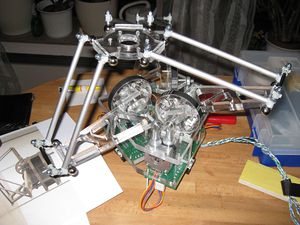Magnet joint
It has been proposed that this page should be moved to Magnetic Ball Joint. Please voice your opinion in the discussion page.
Magnet joints are much easier and quicker to assemble than other joints. This makes them popular for making small scale models of mechanical arrangement, to check for mechanical interference, singularities, etc. before committing to a full-size machine with "proper" joints.
Some early RepRap/RepStrap prototypes, such early Delta and Viktor's tripod repstrap demonstrator, used magnet joints.
With the magnets on hand, these magnetic joints held 3 kg per joint.[1]
That seems to be more than enough to hold up a Bowden extruder at reasonable levels of acceleration and vibration. Which makes some people ask: why bother with complicated, difficult-to-assemble "proper" joints when magnetic joints work just as well, and perhaps better?
- RepRap forum: "Magnetic joints and self assembling"
- http://forums.reprap.org/file.php?14,file=219,filename=VDX-Tripod_kl.jpg
- http://forums.reprap.org/file.php?14,file=291,filename=Mini-Tripod1b.jpg
- "self-assembling magnetic joints"[2]
- BBC: "Build-your-own toy robot construction kits unveiled"; and Erik Sofge. "The Modular Robots Are Coming, One Toy At A Time", a Popular Science blog post, mentions two robot systems held together by magnetic joints:
- John Romanishin at MIT makes M-Blocks, using cylindrical magnets on each edge of each cube that directly attract and align the corresponding cylindrical magnet on its neighbor.
- "Moss: a Modular Robotics Toy for All Ages"; "MOSS: A Simple Magnetic Robotics Kit" which uses small disk magnets molded into the each corner of each cube, which indirectly connect to neighboring cubes via otherwise unattached (non-magnetized?) steel balls.
- RepRap forums: "Sextupteron" has a long discussion of various magnet joints and where to get parts. Some people worried that using a magnetized ball may suffer from pole misalignment, and suggested cylinder-ball or cylinder-ball-cylinder may be a better arrangement, where the cylinders are magnetized with a pole on the flat end that touches the ball, and the ball is a (non-magnetized) steel ball.
